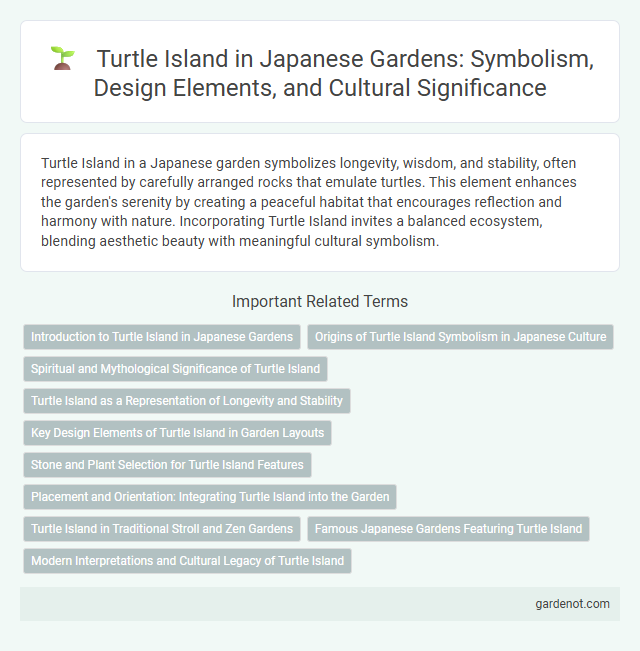Turtle Island in a Japanese garden symbolizes longevity, wisdom, and stability, often represented by carefully arranged rocks that emulate turtles. This element enhances the garden's serenity by creating a peaceful habitat that encourages reflection and harmony with nature. Incorporating Turtle Island invites a balanced ecosystem, blending aesthetic beauty with meaningful cultural symbolism.
Introduction to Turtle Island in Japanese Gardens
Turtle Island, or Kamejima, represents longevity and good fortune in Japanese garden design, symbolizing the mythical turtle believed to live for thousands of years. This small island is often strategically placed in ponds to create a natural focal point, reflecting harmony and balance. Its presence enhances the garden's aesthetic by embodying cultural values and inspiring tranquility.
Origins of Turtle Island Symbolism in Japanese Culture
Turtle Island symbolism in Japanese culture originates from ancient folklore where turtles represent longevity, wisdom, and protection. This motif draws heavily from Chinese mythology, where the turtle carries the world on its back, symbolizing stability and endurance. In Japanese gardens, Turtle Island serves as a microcosm of these beliefs, embodying harmonious balance and eternal life.
Spiritual and Mythological Significance of Turtle Island
Turtle Island in Japanese gardens symbolizes longevity, wisdom, and stability, deeply rooted in Shinto and Buddhist beliefs. The tortoise shape represents the cosmic mountain, connecting heaven and earth and serving as a spiritual bridge in garden design. Its mythological significance often portrays protection and good fortune, embodying harmony between nature and the divine.
Turtle Island as a Representation of Longevity and Stability
Turtle Island in Japanese gardens symbolizes longevity and stability, reflecting the cultural reverence for turtles as sacred creatures embodying endurance and resilience. This small island often features a turtle-shaped rock or stone arrangement, serving as a focal point that promotes a serene and balanced atmosphere. Its presence in the garden evokes a sense of timelessness and steadfastness, reinforcing the garden's harmonious connection with nature and tradition.
Key Design Elements of Turtle Island in Garden Layouts
Turtle Island in Japanese garden design is characterized by its symbolic shape resembling a turtle, embodying longevity and stability. Key design elements include strategically placed rocks and moss to mimic the turtle's shell, as well as surrounding water features that create the illusion of the island floating. The integration of carefully pruned trees and subtle elevation changes enhances the naturalistic appearance and harmony within the garden layout.
Stone and Plant Selection for Turtle Island Features
Turtle Island in a Japanese garden incorporates meticulously chosen stones such as smooth river rocks and weathered granite to represent the island's natural contours and enhance visual harmony. Plant selection centers on mosses, ferns, and dwarf evergreens like Japanese black pine, emphasizing textures and shades that evoke tranquility and balance. These elements combine to create a serene miniature landscape that embodies the symbolic turtle, a traditional emblem of longevity and stability.
Placement and Orientation: Integrating Turtle Island into the Garden
Turtle Island is strategically placed in the central pond of the Japanese garden, creating a focal point that enhances the overall harmony and tranquility. The orientation of Turtle Island aligns with the garden's main pathways and sightlines, ensuring seamless visual connectivity and balance within the landscape. This thoughtful integration highlights the island's symbolic significance, representing longevity and stability in traditional Japanese garden design.
Turtle Island in Traditional Stroll and Zen Gardens
Turtle Island is a prominent feature in Traditional Stroll and Zen Gardens, symbolizing longevity and stability through its turtle-shaped land formation. In these Japanese garden styles, the island often serves as a focal point within ponds, enhancing the harmonious balance between water, rocks, and plant life. The integration of Turtle Island reflects the deep cultural reverence for nature's symbolism and the Zen principles of tranquility and reflection.
Famous Japanese Gardens Featuring Turtle Island
Turtle Island, or Kamejima, is a central feature in many famous Japanese gardens, symbolizing longevity and stability. Renowned gardens like Kenrokuen in Kanazawa and Ritsurin Garden in Takamatsu prominently showcase Turtle Island as a small, carefully crafted islet within their ponds, enhancing aesthetic harmony and spiritual balance. The island often serves as a natural focal point, integrating traditional Japanese landscaping techniques with cultural symbolism.
Modern Interpretations and Cultural Legacy of Turtle Island
Turtle Island in Japanese gardens symbolizes longevity, resilience, and harmony with nature, often reimagined through minimalist design and contemporary materials that emphasize its spiritual essence. Modern interpretations incorporate abstract, sculptural elements reflecting environmental mindfulness and cultural continuity. Its cultural legacy persists as an emblem of traditional Japanese aesthetics while inspiring innovative garden art and ecological awareness worldwide.
Turtle island Infographic

 gardenot.com
gardenot.com